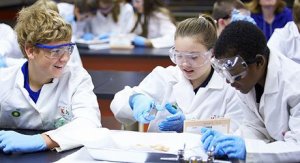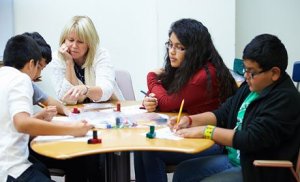Field Trip Partnerships: Student-to-Student Mentoring
On a middle school field trip to a high school, the older students instruct and inspire those who will soon join their ranks or follow in their footsteps.
Your content has been saved!
Go to My Saved Content.Children running wild enjoying a day of freedom, exhausted chaperones, budget-conscious, hand-wringing administrators back at school -- all of these conjure troubling images for educators about field trips. These are far from the enjoyable, state-of-the-art, educational experiences that field trips could be for today's teachers and students.
For several years, the Illinois Mathematics and Science Academy (IMSA) has had longstanding partnerships with school districts throughout the state which have involved designing STEM field trip experiences that serve middle school educators and students. These field trips to the Academy are led by IMSA high school students who are enrolled in the Allies program.
IMSA Allies: Student-on-Student Mentoring
The Allies program name began as an acronym (Active Learning Leading Integrative Explorations Scholarships) and evolved into the single word whose meaning captures the program's essence. Synonymous with "partner," the word "ally" is defined as "one in helpful association with another." The best way to describe Allies is an after-school youth development service-learning program in which IMSA students prepare to deliver inquiry-based, hands-on science, technology, engineering, and mathematics (STEM) activities to younger students. It integrates the teaching of science, service learning, and leadership skills development.

But Allies is much more. Participants learn 21st-century workforce-readiness skills, including best practice collaboration, critical thinking, and effective communication skills. In this student-centered program, Allies/IMSA students develop a deeper, more complete conceptual understanding of STEM. Through weekly sessions and trainings, they refine their thinking, prepare the delivery of STEM content, and teach one another -- discovering that the best way to gauge concept mastery is by teaching it to someone else. In this kids-teaching-kids model, IMSA students gain invaluable experiences as educators, and middle school "field trippers" benefit as learners.
Field Trips: Partnerships Between Schools
For field trippers, visiting the Illinois Mathematics and Science Academy provides "fields of fun" experiences with student-to-student mentoring and hands-on educational activities in science and mathematics. Field trip experiences are dually delivered: IMSA educators teach mathematics enrichment sessions, and Allies/IMSA students teach laboratory-based science sessions -- including dissections. From squid to starfish and slime to snow, Allies inspire younger students and ignite their enthusiasm, curiosity, and interest in STEM. Along with mathematics and science sessions, field trippers enjoy lunch in the IMSA cafeteria, followed by a campus tour. This special partnership program offers a model for enriching education across grades, develops partnerships between schools, and provides opportunities for student-to-student mentoring and learning.

For over a decade, this effective teaching and learning model has evolved at IMSA, creating conditions for students to appreciate the importance and impact of education, leading them to forge connections between what they already know to what they can learn in the future. Allies students are trained in content and pedagogy, deliver challenge-based curricula that progress in difficulty, and learn through the scaffolding process. They see their potential as leaders in STEM education. Middle school students acquire knowledge through shared experiences, which create extended learning opportunities involving hands-on experiences, deeper learning in STEM, and a glimpse of what a STEM residential high school looks like.
But the benefits go beyond students. Teachers and parents gain exposure to new opportunities and resource sharing, and the ties between community and schools are strengthened by this exchange.
Developing and Implementing a Field Trip Program in Your School District
When resources are slim, traditional field trips become few and far between for students and teachers -- but if schools can work together locally, field trips become so affordable that schools can develop and implement these state-of-the-art educational experiences. Here's what we recommend for launching a similar program in your district:
- Support: Get school leaders talking about piloting a similar program -- something as doable as your middle school visiting the high school. What's possible? What's needed?
- Resources: Consider what could be pooled within your district and then start talking to nearby schools. Consider sharing the costs of materials, equipment, meals, facility use, and transportation.
- Sponsors: What teachers could sponsor an Allies-type program? What additional support might be provided by a local community college's workforce development program?
- Curriculum: Make curricular connections through grade levels and determine what hands-on activities students can do. Work together to create opportunities for middle school students to participate in experiments in a high school science lab, allowing for a preview of what's to come. Meaningful field trips are carefully explored, well-planned activities.
IMSA's field trips are designed for middle school students to meet and learn from high school students, but this model is scalable and replicable. Clearly, involving students and teachers from across grade levels (elementary through secondary) is an effective way to build strong district-wide, regional, and community-based support in a way that is financially feasible and educationally sound. Providing opportunities for enriched learning outside of the classroom begins by dreaming out loud about the possibilities for coordinating partnerships between schools and opportunities for student-to-student mentoring. What's possible for your field trippers? Some ideas might include game days, music rehearsals, lab sessions, tech starters, assembly programs, math workshops, and fine arts exhibits.
Editor's Note: STEM education advocate Robyn Lee-Diaz co-authored this post.
